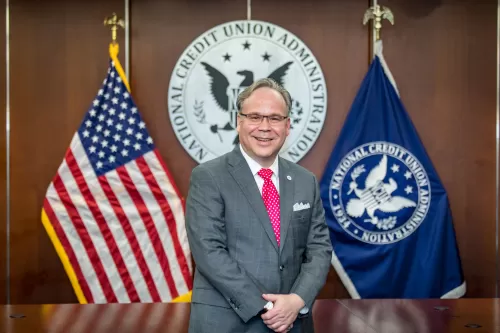NCUA Chairman Todd M. Harper at the NCUA's headquarters in Alexandria, Virginia.
As Prepared for Delivery on January 27, 2022
Thank you, Anthony, for your informative briefing on the status of the Central Liquidity Facility, or CLF, following the expiration of its enhanced statutory authority at the end of 2021.
Before proceeding, I first want to congratulate you, Anthony, on your selection as CLF President. I am confident that the Central Liquidity Facility will be well-managed under your steady hand and that with your vision the CLF will achieve its full potential.
With currently more than $26 billion in borrowing capacity, I am pleased to see the CLF remains a strong source of emergency liquidity should the need arise in 2022. However, the expiration of the enhanced borrowing authority and other CLF provisions in the Coronavirus Aid, Relief, and Economic Security Act, or CARES Act, is concerning, especially with the pandemic and its financial and economic disruptions continuing into this year.
That is why my follow Board members and I continue to call on Congress to make permanent the legislative enhancements contained in the CARES Act. I thank Vice Chairman Hauptman and Board Member Hood for their efforts in support of this critical legislative effort. And, we will continue our efforts to make these changes permanent, if possible, and support interim measures like a temporary reinstatement of this authority.
Restoring these enhancements would ensure there is a strong liquidity backstop for the credit union system should the need arise in the future. Restoration would also provide regulatory certainty for federally insured credit unions and bolster the credit union system’s ability to respond to future emergencies with the CLF serving as an essential shock-absorber for the system and the National Credit Union Share Insurance Fund.
In times of economic prosperity, the U.S. financial system often has ample liquidity available for those that need it. However, as we have seen during times of economic and financial stress, like in 2008, that liquidity can quickly dry up, leading to significant risks for credit unions and the broader financial system if the lack of liquidity is not quickly addressed. That is why the financial system has federal liquidity backstops built in — like the Federal Reserve’s Discount Window and the NCUA’s CLF — to provide essential liquidity to maintain stability and confidence during economic downturns and periods of financial stress.
While credit unions, overall, have so far weathered the pandemic well and the system continues to have ample levels of liquidity primarily because of a large inflow of fiscal support during the last two years, all of us must recognize that much economic uncertainty remains as we start 2022. The rapid spread of the Omicron variant and continued supply chain disruptions are affecting consumer pocketbooks, labor markets, and businesses.
What is more, for the first time in more than 40 years, Americans must deal with inflation. Higher inflation has led the Federal Reserve’s Federal Open Market Committee to announce that it will remove its monetary policy accommodation more aggressively, with many economic forecasters expecting these measures to begin as early as March. These economic challenges will place additional stress on household finances and financial markets, and that stress could have negative implications for credit union performance in the coming months.
We also know from painful experience that we can expect credit unions’ liquidity to increase any time there are economic contractions. Like firefighters responding to a blaze, the NCUA needs to be ready to provide that emergency liquidity quickly before the lack of liquidity spreads and undermines the strength and stability of the credit union system. The return to a pre-CARES Act structure for the CLF will impede the NCUA’s ability to respond effectively to future shocks.
Before closing, I have two questions. First, Anthony, why was the enhanced authority for the CLF under the CARES Act so important to the credit union system? And, does the CLF have a role in supporting the credit union system during periods of relatively good financial and economic performance?
Thank you for that response. Second, what external factors justify having this enhanced authority for the CLF and the potential for liquidity needs over the long term?
Thank you for outlining why this enhanced authority is still needed for the NCUA and for the credit union system.
Again, I want to assure all stakeholders that restoring and making permanent the enhanced authorities provided to the Central Liquidity Facility as part of the CARES Act remains front and center for the NCUA. My fellow Board members and I are committed to working with Congress on this vital legislative priority.
That concludes my remarks. I now recognize Vice Chairman Hauptman.



